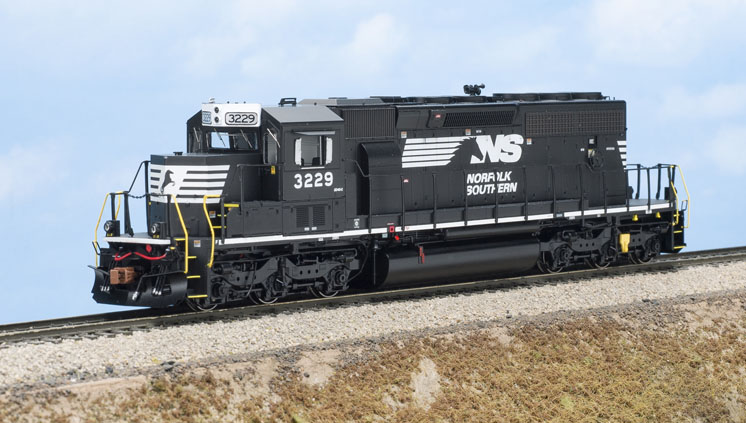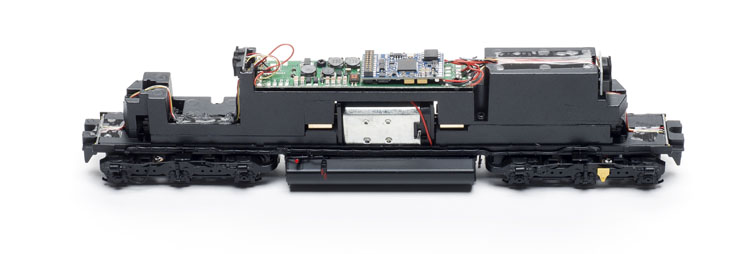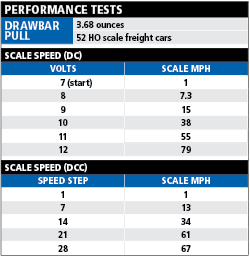While this isn’t the first HO scale SD40-2 to roll down the tracks, ScaleTrains.com takes a different route by offering many options on drive and detail level, including variations that haven’t been available in plastic before. Electro-Motive Division’s SD40-2 diesel was General Motors’ all-time best-selling locomotive, so there are plenty of them to make models of.
The prototype. General Motors’ Electro-Motive Division began offering the SD40-2 in 1972, part of its upgraded Dash 2 line of locomotives. By the time production ceased in 1986, nearly 4,000 SD40-2s had been built.
Like the roughly 3-foot shorter SD40 before it, the SD40-2 used a 3,000 hp 16 cylinder 645E diesel engine. The Dash 2 part of the name applied primarily to the improved electronics, but most of the locomotives also used EMD’s new high-adhesion HT-C trucks in place of the Flexicoil trucks used on previous six-axle locomotives. Conrail opted for Flexicoils on its orders. The HT-C trucks are longer than the Flexicoil Cs, necessitating the longer frame.
The model. ScaleTrains.com offers the SD40-2 in two lines, Operator and Rivet Counter. The Operator models have simpler details, but ScaleTrains.com offers a detail kit with many of the Rivet Counter add-ons for $27.99. Both lines are also available as either direct-current (DC) or Digital Command Control (DCC)-equipped models with dual-mode ESU LokSound V4.0 sound decoders.
The Rivet Counter models, such as the Norfolk Southern SD40-2 we reviewed, have separately applied metal grab irons and lift rings, underbody details, extra truck details, detailed pilots, and more comprehensive decoration, including myriad warning labels almost too small to read.
All dimensions match prototype drawings in Model Railroader Cyclopedia: Vol. 2, Diesel Locomotives (Kalmbach Publishing Co., out of print). The black paint on our sample was evenly applied, though there were only a few small voids in the NS horsehead logo on the long hood, which could be easily filled with dabs of white paint.
The review model is Norfolk Southern 3229, which was rebuilt in 2013 from a Southern high-short-hood unit to “Admiral” cab specifications in NS’s Juniata Shops in Altoona, Pa. This is the first plastic model featuring the Admiral cab, which has a forward-tilted windshield similar to those found on ships. Other Juniata details are also modeled.
ScaleTrains.com has included see-through radiator fan shrouds with fan blades below, and the dynamic brake grills are open with barely discernible brake grids behind them. The cab features a detailed control stand, rear bulkhead, seats, and positionable windows, but there are no figures inside.
The locomotive comes with ScaleTrains.com’s die-cast metal semi-scale couplers. I had a little trouble getting them to gently couple with other manufacturer’s couplers in some instances.
ScaleTrains.com has noted an issue with replacing its couplers with Kadee whisker couplers or Sergent scale couplers. The factory-installed draft-gear boxes are too narrow to allow full motion of these couplers. New draft-gear boxes will be fitted to later runs of the SD40-2, and the parts will be available for current models at a later date. ScaleTrains.com notes the existing draft-gear boxes can be filed to allow more coupler swing.
The skew-wound can motor is mounted above the fuel tank. Brass flywheels on both ends of the motor connect to plastic driveshafts, which mate with the worm gears on the truck towers. All 12 wheels are powered and also pick up electricity from the rails.
Plastic light tubes conduct the light from surface-mount light-emitting diodes (LEDs) mounted to the frame to the headlights and number boxes.
On the test track. When I first set the model on the track and fired up an NCE PowerCab DCC system, the locomotive remained silent until I pressed function button 8. Then, the sounds of an EMD 16-645E diesel engine starting up came pouring out of the speaker. The ESU LokSound V4.0-equipped SD40-2 started moving in speed step 1 at 1 scale mph. By speed step 28, it had reached 67 scale mph, which is close to the 65 mph top speed of a typical SD40-2 with the standard 62:15 gear ratio.
ESU programs its decoders with what seems to me to be a reasonable amount of momentum, so the only change I made initially was setting the decoder address to match the cab number. After operating the locomotive on our staff layout, the Milwaukee, Racine & Troy, I made a few changes to remap some function keys.
The decoder is equipped with ESU’s Full Throttle suite of control features, and I wanted to take advantage of the Independent Brake, which is programmed to function 10. This requires a shift-key sequence on our NCE throttles, so I remapped the Independent Brake to function 5, which is unused on the NS SD40-2 model.
I used a LokProgrammer computer interface from ESU (manufacturer’s suggested retail price $179.99), but if you don’t want to buy the hardware, it’s possible to use the free LokProgrammer software to determine the configuration variable changes needed to remap the functions. ESU’s YouTube channel has a video explaining how to do this.
In DC, the sounds on the dual-mode decoder started at 6.2V and the model started moving at 1 scale mph at 7V. At 12V, the model reached 79 scale mph.
All sound and lighting functions in DC are automatic. The headlights illuminated in the direction of travel, and the engine rpm increased with locomotive speed. Changing direction resulted in a momentary drop in sound, but the engine didn’t replay its start-up sequence.
On the layout. I took the SD40-2 to our staff layout, the Milwaukee, Racine & Troy, to explore its performance on a model railroad. The sounds of the 16-645E diesel engine ramped up and down realistically as I advanced and reduced the throttle while assembling my train in the Williams Bay yard.
Once I had my 13-car train together, I took it up over Winter Hill, a 3 percent grade. The locomotive had no trouble with its load, and I used the Full Throttle Drive Hold feature on function 9 to simulate the engine revving higher while the locomotive maintained speed with its heavy load. Our test meter measured drawbar pull of 3.68 ounces, equivalent to 52 free-rolling HO scale freight cars on straight and level track. When I sounded the horn, the ditchlights flashed. This is prototypical for Norfolk Southern practice.
The ESU PowerPack capacitor system kept the locomotive moving through a couple of troublesome spots where turnouts have lost continuity over the years.
The next lap around, I consisted the locomotive with a General Electric 8-40BW from Atlas with an older LokSound Select decoder. Advanced consisting was simple using our NCE system, and the two locomotives easily handled the train without any additional speed matching required.
Whether you want a fully detailed model with traction motor cables and all the bells, whistles, and lighting effects; or a basic DC model without all the frills, ScaleTrains.com has you covered. This SD40-2 is a solid performer and should be right at home on any contemporary layout.
Manufacturer
ScaleTrains.com Inc.
7598 Highway 411
Benton, TN 37307
www.scaletrains.com
Prices: Rivet Counter line, $149.99 (DC only), $219.99 (DCC and sound); Operator line, $79.99 (DC only), $119.99 (DCC and sound)
Era: 2013 to present (as detailed and decorated for Norfolk Southern)
Roadnames: Rivet Counter line: Norfolk Southern; Atchison, Topeka & Santa Fe Burlington Northern; Chessie System; CSX; Chicago & North Western; Milwaukee Road; Southern Ry.; Union Pacific. Operator line: BNSF, CSX, Norfolk Southern, Union Pacific
Features
Operator line
• Five-pole skew-wound motor with dual brass flywheels
• All-wheel drive and electrical pick-up
• Directional LED headlights and lighted number boxes
• Minimum radius: 18″, recommended radius 22″
• ScaleTrains.com plastic semi-scale E Type knuckle couplers mounted at correct height
Rivet Counter line, same as above, plus:
• Factory-applied wire grab irons, wire lift rings, windshield wipers, snowplows, horns, uncoupling levers, and trainline hoses
• ScaleTrains.com metal semi-scale E Type knuckle couplers mounted at correct height
• Weight: 18.2 ounces
















